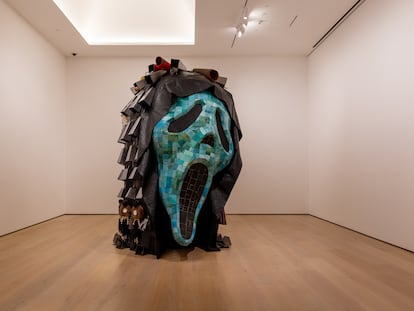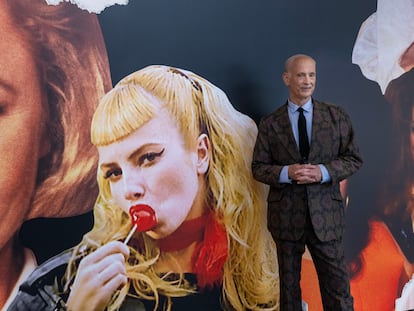‘The Great Wall of Los Angeles’: An alternative version of US history turned into street art
The prodigious mural project started by Judy Baca in 1976 finds new momentum with LACMA’s first solo exhibition dedicated to the Chicana artist
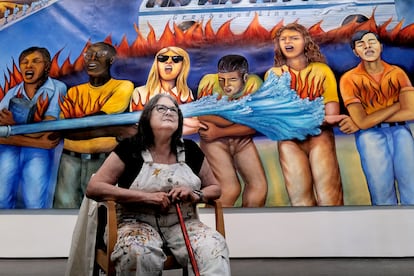

Schools have taught alternative versions of United States history for decades — a fact that continues to be the source of controversy. Hundreds of books have been devoted to reviewing and reinterpreting the country’s founding. Political discourse has changed too, incorporating new points of view. In Los Angeles, Judy Baca chose to tell her version of the nation’s unofficial history out in the open and for all to see. The Chicana artist and activist — one of the movement’s most important figures — has been doing this work since 1976, concentrating her efforts in a project that has survived to the present day: The Great Wall of Los Angeles.
With a bit of luck, anyone who visits the Resnick Pavilion at the Los Angeles County Museum of Art (LACMA) in the coming months will see Baca, dressed in a paint-splattered jumpsuit, working on a new section of the gigantic mural, to eventually join with its larger whole, which is located in the LA’s San Fernando Valley, and is considered one of the largest murals in the world. Its sweeping scenes feature leaders from the farmworkers’ movement that famously called for a boycott of Central California grapes to demand better conditions for workers, many of them immigrants. César Chávez appears on one panel, holding a flag, as does Dolores Huerta, who holds a megaphone in her hand. There are lesser-known characters as well, like the Filipino labor organizer and movement leader, Larry Itliong.
“It’s a story of evolution,” says Baca, as she sits on a small stool and paints the face of the famous United Farm Workers leader. “As much as I’ve tried to make it about Los Angeles, it’s also a national story.” The 77-year-old artist, the granddaughter of Mexicans who migrated to Colorado, learned to paint to scale in the studio of Mexican muralist David Alfaro Siqueiros. Now, she comes to the museum two or three times a week to sketch out the 60-foot-long scene with thick blue paint. She starts the process, then her team covers the canvas in a monochrome wash that adds dimension and highlights the darker colors.
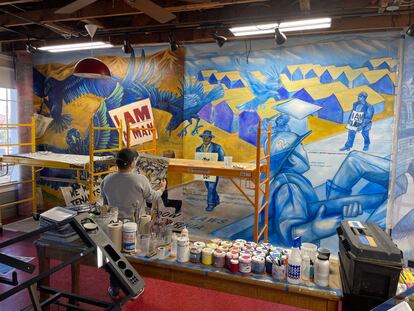
An example of the final result, in bold, high contrast colors, is displayed in the same room. Generation On Fire shows a group of young activists, linked in a human chain, sprayed by firehoses and surrounded by a circle of fire. The section is a nod to the Freedom Riders, the students who traveled in buses from Washington in 1961 to the southern states to support efforts against racial segregation.
Baca and her team will work at LACMA through June 2024 to complete another 135 feet of the mural. This will be in addition to the more than 2,750 feet that already exist along the Tujunga Wash, a tributary of the Los Angeles River, just north of the city. That main section was painted over the course of seven summers, from 1976 to 1983, with the help of some 400 low-income youth, artists and community members. The work has benefited from a second boost since 2021, when the artist and her team received a five million dollar grant from the Andrew W. Mellon Foundation to expand the project. The mural will stretch nearly one mile long by 2028, when Los Angeles will host the Olympic Games.
Baca’s presence at LACMA is a vindication of her life’s work. The Chicana activist, who grew up during a time when speaking Spanish was not allowed in her school, said that decades ago, she was uninterested in having her work featured in museums because they belittled her identity. Times have changed. Now, a major LA art institution has offered Baca her first solo exhibition of her career, and organized a gala in her honor, which also celebrated the work of filmmaker David Fincher.
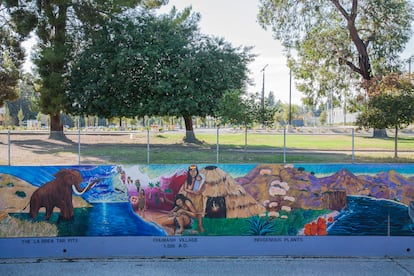

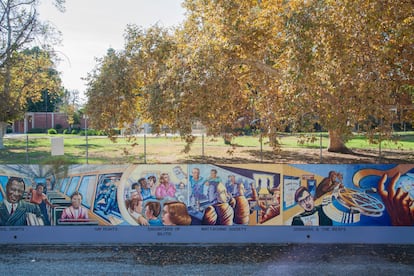

“Judy grew up with the Chicano movement of the 1960s, at a point in history when there was no recognition of muralism or Mexican-Americans in the institutions. It’s been an adventure to watch it develop and to see the impact it has today in different communities. Now her work is considered very important by curators and historians,” says Delia Sofía Zacarías, who curated the exhibition, which is titled Painting in the River of Angels: Judy Baca and The Great Wall.
The Great Wall began as a work commissioned by the Army Corps of Engineers, which was building a channel system to prevent the Los Angeles River from flooding. At first, Baca proposed using the concrete walls to tell the story of California from prehistoric times to 1940. The program was a success, and was applauded as a path toward community integration for hundreds of youth caught up in the court system on various charges. “The project showed that young people who are prone to getting into trouble also tend to be the most creative,” Baca asserted in a letter to City Hall in the 1980s. The mayor of Los Angeles at the time, Tom Bradley, commissioned the painter and her team of artists to complete 47 murals in the lead up to the 1984 Olympic Games.
After years relegated to the margins of the LA art world, Baca’s great work has finally achieved mainstream recognition as it approaches its 50-year anniversary. The artist’s archive, which includes the original sketches of the mural, photographs, maps and correspondence between the painter and her team, was acquired a few years ago by George Lucas. Lucas, a director and patron of the arts, plans to incorporate these elements into a collection at the museum he is building in the heart of the city, dedicated to narrative art.
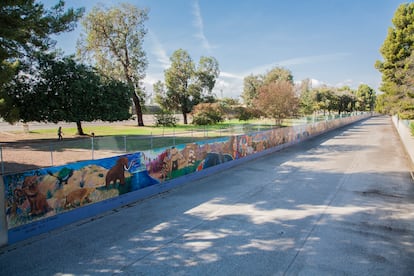
Over the coming few months, people can watch Baca working on the mural at LACMA, but the enormous project is simultaneously under way in another part of the city, inside a former prison in Venice, a neighborhood on LA’s Westside. The building is the headquarters of the Social and Public Art Resource Center, an organization better known by its acronym, SPARC. The space is the main center of operations and activism for Baca and her fellow artists. In the back section of the building, two teenagers are looking over some old photographs and other visual references displayed on large monitors to ensure the details they paint on future murals are accurate. “Our work is important because it’s telling the history of things that have been forgotten or actively suppressed,” says Rachel, one of those charged with the task of finding and displaying photos. “It’s a history that’s not in books, and we have to create images of events that sometimes don’t have any existing images.”
In another part of the building, Toria Maldonado works on the coloring for a different scene: crows flying over a row of houses. In one of their talons, a bird holds a sign that reads, “We want white tenants in our white community,” as it flies away. On the street below, a man holds a sign reading “I Am a Man,” one of the most famous phrases of the Civil Rights Movement. The scene is highlighted in electric blue, a sure sign that Judy Baca’s brush has already passed over it. Soon, the scene will be rolled up into a scroll — a technology created by SPARC — and transferred to its new home along the river. There, it will tell a little-known story to anyone who passes by.
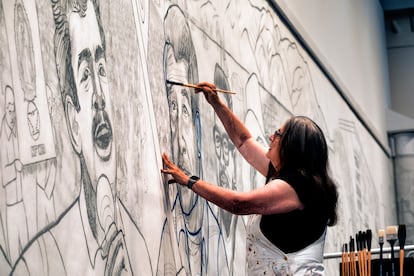
Sign up for our weekly newsletter to get more English-language news coverage from EL PAÍS USA Edition
Tu suscripción se está usando en otro dispositivo
¿Quieres añadir otro usuario a tu suscripción?
Si continúas leyendo en este dispositivo, no se podrá leer en el otro.
FlechaTu suscripción se está usando en otro dispositivo y solo puedes acceder a EL PAÍS desde un dispositivo a la vez.
Si quieres compartir tu cuenta, cambia tu suscripción a la modalidad Premium, así podrás añadir otro usuario. Cada uno accederá con su propia cuenta de email, lo que os permitirá personalizar vuestra experiencia en EL PAÍS.
¿Tienes una suscripción de empresa? Accede aquí para contratar más cuentas.
En el caso de no saber quién está usando tu cuenta, te recomendamos cambiar tu contraseña aquí.
Si decides continuar compartiendo tu cuenta, este mensaje se mostrará en tu dispositivo y en el de la otra persona que está usando tu cuenta de forma indefinida, afectando a tu experiencia de lectura. Puedes consultar aquí los términos y condiciones de la suscripción digital.
More information
Archived In
Últimas noticias
Most viewed
- Sinaloa Cartel war is taking its toll on Los Chapitos
- Oona Chaplin: ‘I told James Cameron that I was living in a treehouse and starting a permaculture project with a friend’
- Reinhard Genzel, Nobel laureate in physics: ‘One-minute videos will never give you the truth’
- Why the price of coffee has skyrocketed: from Brazilian plantations to specialty coffee houses
- Silver prices are going crazy: This is what’s fueling the rally
